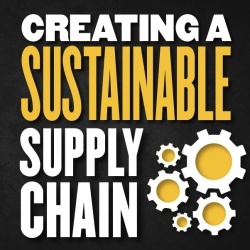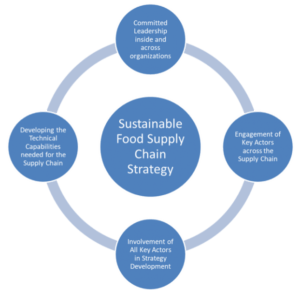Creating a Sustainable Supply Chain
 Journal
Journal
Authors: Stuart Orr and Akshay Jadhav
Journal: Creating a sustainable supply chain: the strategic foundation, Journal of Business Strategy, Vol. 39 Issue: 6, pp.29-35, https://doi.org/10.1108/JBS-11-2017-0157 (2018)
Reviewer
Dr. Allan Gray, Executive Director and Professor
Summary
This article examines the strategic elements required for the development of an effective sustainable supply chain. The authors identify four key strategy elements:
- Personal commitment from senior management to a sustainable supply chain
- Engaging key members of the supply chain in the sustainability initiatives of the organization
- Involving supply chain members in planning for increasing sustainability in the supply chain
- Developing the technical capabilities of all staff for initiatives in the supply chain
The paper identifies unique characteristics of a sustainable supply strategy that are not part of standard business strategy, including: 1) developing a common language for sustainability among supply chain participants, 2) involvement of all supply chain participants in internal sustainability initiatives and 3) planning for the use of resources external to the organization to achieve greater sustainability performance.
What this means for Food and Agricultural Business
The desire to create sustainable food supply chains is on the rise in the U.S. and around the world. Recent investments in the agricultural retail space including Nutrien’s purchase of Agrible and Land O’Lakes investment in SUSTAIN are illustrations of how sustainability in the food supply chain is not just for the Nestle and Unilever’s of the world focused on developing countries anymore. All across the food and agricultural supply chain participants are looking for ways to reduce their environmental footprint, reduce waste, reduce cost, enhance worker safety and improve the communities where they live and work. They are also seeking to improve profitability by differentiating themselves in the marketplace as a transparent sustainable business and contributor to society with traceable metrics to illustrate their progress in sustainability.
But the food and agriculture supply chain is an intricate and complicated puzzle of actors all sharing the activities necessary to feed, fuel and cloth the population. Sustainability in the food and agricultural supply chain cannot lie within just one firm. To have credible sustainability impacts, firms across the chain have to work together to create a strategy. This strategy must have clear metrics for environmental, societal and economic impacts. The strategy also needs to include clear incentives, responsibilities and risk sharing parameters for all parties in the chain.
This is where this article creates a strong contribution to the challenges in the food and agriculture sustainability space. The article lays out four critical components to the development of a successful sustainable supply chain strategy. While the article does not focus on food and agriculture, I believe their findings are just as relevant. Let’s look at each of the four elements of their strategy framework from a food and agriculture perspective (see figure 1).
Personal commitment from senior leadership
Creating a company culture where environmental, societal and economic impacts carry equal importance has to start from the top of the organization. Senior management commitment is required because the change in company processes and human behavior is a significant departure from common practice. As with any change management process, resistance to the needed changes in practices, metrics and behaviors is almost a certainty. For example, the “get it done” mentality of our farmers and input service providers—often understandable due to the time pressures of mother nature—may need to change when weighing factors such as worker safety, environmental impacts from drift, runoff, volatilization, etc. Common practices of fall application of fertilizer may need to be weighed against impacts on water quality, and innovations may need to be discovered to balance the need for fall application to reduce the demands on the workforce in the spring. These types of changes are difficult to execute, but without top management’s commitment to the change, any initiatives are doomed to fail.
Engaging key members of the supply chain
People, and companies, in agriculture have a reputation of being fiercely independent. They have relied on open markets and arms-length-exchanges across the value chain. The food side of the industry has also preferred not to engage much with agriculture and let the markets determine the exchange of raw materials for food items. As the demand for more sustainable food supply chains increases, it requires that food and agribusiness companies across the chain become more dependent on each other. Sustainable food supply chains require actors across the chain to act in unison, be accountable for their actions, and share openly to allow sustainable metrics to be tracked and traced across the system. Here again, it will require strong leadership from top managers to guide the needed coordination across firms.
Involving Supply Chain Members in the strategy
Just as the food and supply chain actors will have to work with each other to have meaningful sustainability impacts, they will also have to be willing to openly share the development of strategy across the chain and align those strategies within their own businesses. A sustainable food supply chain strategy that is not aligned with the individual firms’ strategies is also doomed to failure due to misalignment of incentives and/or pressures by individual actors to shirk accountability. Alignment of chain and firm strategies is a give-and-take process. The alignment requires flexibility and openness to allow chain actors outside of the individual business to become more intimately familiar and engaged with the individual company’s strategy. Here, the development of strong relationships and trust among the actors in the supply chain will be crucial to the successful development of the strategy.
Developing technical capabilities
The food and agricultural supply chain is very complex with a tangled mixture of hard sciences and social sciences all working together (or in conflict at times) to meet the needs of consumers. As the chain aligns to meet the sustainability demands of the future, human talent must be capable of understanding, communicating and executing on this mixture of sciences in new ways. Talent that is able to track and trace activities both within and across firms must be developed. Talent that can establish relationships across firms to build trust and create interdependencies that allow for successful implementation of the sustainable food supply chain strategies must also be developed. Finally, talent that can drive innovation to constantly improve the impacts of the sustainable food supply chain strategies needs to be developed.
As you consider where you want to fit into this coming shift to sustainable food supply chains, you should ask yourself these key questions:
- To what extent are our leaders visibly committed to sustainability?
- To what extent are suppliers and customers across the chain involved in our current sustainability initiatives?
- Would suppliers and customers be prepared to be involved in the development of an initiative?
- Does the current communication with supply chain members support such an initiative?
- Do our employees and supply chain members have sufficient technical competence to develop a sustainability strategy?

Figure 1: The four Reinforcing Elements of a Sustainable Food Supply Chain Strategy
RELATED POSTS:
A great moment for value-based sales in agribusiness
Value-based sales can empower companies to craft compelling value propositions, understand the customer’s business model and effectively communicate to stakeholders.
How can big data empower the development of new products?
Data is one of the most powerful resources for a company. It enables accurate decision-making and minimizes risk, ensuring greater revenue and sustainable growth.
Unlocking Growth: Exploring innovation dynamics in the agrifood sector
The future for the agrifood sector appears promising, driven by technological advances, strategic M&A activity and a growing commitment to innovation.
